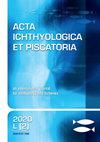通过测量毛细血管中红细胞大小无创测定活鱼的倍性
IF 0.8
4区 农林科学
Q3 FISHERIES
引用次数: 0
摘要
关于倍性的信息在商业和保护性水产养殖以及鱼类研究中都很重要。不幸的是,用于其测定的方法,例如核小体学、使用微密度计或流式细胞术测定细胞中DNA的量和/或测量血液涂片中的红细胞,可能是有压力的,甚至是破坏性的。其中一些方法也受到被测量个体相对较大的最小尺寸的限制。本研究的目的是测试一种新的低应力方法,通过测量鱼类(包括小个体)毛细血管中红细胞的大小来确定倍性。首先,我们使用流式细胞术和血液涂片检测了二倍体和三倍体泥鳅(Cobitis sp.)和吉贝鲤鱼Carassius gibelio(Bloch,1782),并将这些结果用作对照。随后,我们在光学显微镜下测量了已知倍性的麻醉鱼类尾鳍毛细血管中红细胞的大小。与基于流式细胞术和血液涂片的对照组相比,对于泥鳅和钩尾鱼,直接观察上皮鳍毛细血管中的平均红细胞大小可以提供一致和可靠的倍性测定。这种新方法可以快速测定活体小型鱼类的倍性,使用其他方法收集组织可能会造成过度的压力或损伤。这里概述的方法只需要直接测量活鱼血液中的红细胞,从而可以在不需要血样的情况下确定倍性。所描述的方法足够有效,比许多其他程序对设备的要求更低,可以由相对缺乏经验的人员使用,并且在动物福利方面具有好处,这对于鱼类生产设施或处理稀有或濒危物种尤其重要。本文章由计算机程序翻译,如有差异,请以英文原文为准。
Non-invasive ploidy determination in live fish by measuring erythrocyte size in capillaries
Information about ploidy is important in both commercial and conservation aquaculture and fish research. Unfortunately, methods for its determination, such as karyology, determination of the amount of DNA in a cell using microdensitometry or flow cytometry and/or measuring erythrocytes in a blood smear can be stressful or even destructive. Some of these methods are also limited by the relatively large minimum size of the individual being measured. The aim of this study was to test a new low-stress method of determining ploidy by measuring the size of erythrocytes in the capillaries of a fish, including small individuals. First, we examined diploid and triploid loach (Cobitis sp.) and gibel carp, Carassius gibelio (Bloch, 1782), using flow cytometry and blood smears, with these results being used as a control. Subsequently, we measured the size of erythrocytes in the caudal fin capillaries of anesthetized fishes of known ploidy under a light microscope. For both the loaches and gibel carp, direct observation of the mean erythrocyte size in epithelial fin capillaries provided a consistent and reliable determination of ploidy when compared with the controls based on flow cytometry and blood smears. This new method allows for rapid determination of ploidy in living small fish, where collection of tissue using other methods may cause excessive stress or damage. The method outlined here simply requires the measurement of erythrocytes directly in the bloodstream of a live fish, thereby making it possible to determine ploidy without the need for blood sampling. The method described is sufficiently efficient, less demanding on equipment than many other procedures, can be used by relatively inexperienced personnel and has benefits as regards animal welfare, which is especially important for fish production facilities or when dealing with rare or endangered species.
求助全文
通过发布文献求助,成功后即可免费获取论文全文。
去求助
来源期刊

Acta Ichthyologica Et Piscatoria
FISHERIES-ZOOLOGY
CiteScore
2.20
自引率
0.00%
发文量
31
审稿时长
>12 weeks
期刊介绍:
ACTA ICHTHYOLOGICA ET PISCATORIA (AIeP) is an international, peer-reviewed scientific journal that publishes articles based on original experimental data or experimental methods, or new analyses of already existing data, in any aspect of ichthyology and fisheries (fin-fish only).
 求助内容:
求助内容: 应助结果提醒方式:
应助结果提醒方式:


